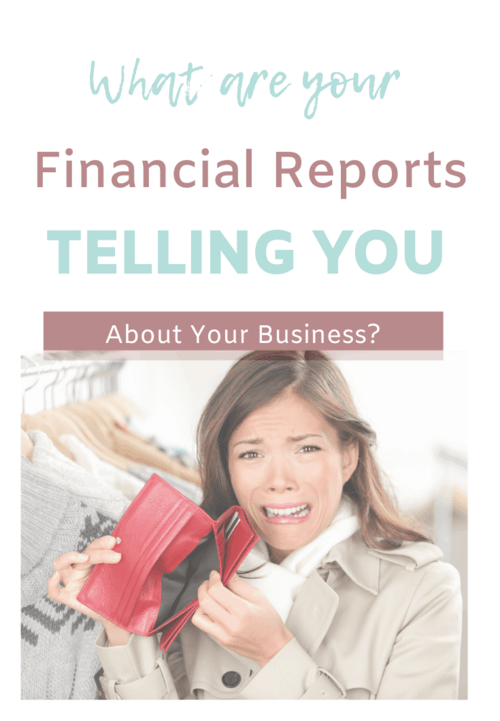It’s a great feeling, isn’t it? Walking out of the accountant’s office after being told you have a great little business that is earning you $$$ net profit!
Finally, you are being recognised as a genuine female entrepreneur, a serious business mogul. You have actually turned your hobby or passion into something real, something that is going to make you RICH. It’s time to celebrate!
Making educated financial decisions for your business means you can confidently put more profit in your pocket – and keep your business running. The reality is that many businesses may turn a profit, but the owners just aren’t seeing any of it land in their pockets. What is going wrong and why are businesses failing?
Too many entrepreneurs are concerned with working in their business and not on their business.
This means relying on other people to tell you what you should learn and know – especially when it comes to your business finances.
Making educated financial decisions for your business means you can confidently put more profit in your pocket – and keep your business running.
Before we jump up on the couch with excitement (like Tom Cruise did when he visited Oprah in 2005 and declared his love for Katie Holmes) – or feel the need to lay down on it, let’s look at the definitions of some key financial terms that you need to know in business:
Key Financial Terms Every Businesswoman Should Know
Assets – things you own. These can be cash or something you can convert into cash such as property, vehicles, equipment and inventory.
Cash flow – the measure of actual cash flowing in and out of a business.
Creditor – a person or business that allows you to purchase a good or service with an agreement to pay at a later date. A creditor is also anyone who you owe money to, such as a lender or supplier.
Debtor – a person or business that owes you money.
Equity – the value of ownership interest in the business, calculated by deducting liabilities from assets.
Liability – any financial expense or amount owed.
Overheads – the fixed costs associated with operating a business such as rent, marketing, utilities and administrative costs.
Profit – the total revenue a business earns minus the total expenses.
Profit and loss statement (also known as an income statement) – a financial statement listing sales and expenses. Use it to work out the gross and net profit of a business.
Know Your Finances
Now you know some of the financial jargon, you’ll be able to better understand what could be happening financially to your business. Your business may show a profit on your accounting reports but you just aren’t taking any of that home. It seems unfair, doesn’t it? After all the blood, sweat and tears you’ve shed building your business. It can happen to anyone and often does. To prevent it from happening to you, here are some things to look out for and be educated about in your business.
I recently had a new client who had been in operation for many years. She felt so strongly about her vision that she had been using her personal finances to prop up her business. Unfortunately, this isn’t sustainable. After some restructuring, hard work and focus, imagine how she felt the following financial year which showed not only her first-ever profit but a six-figure one at that!
Taking a good look at spending, costs and assessing staff requirements meant that she was able to streamline her business and have it working the way it should financially.
What is Cash Flow?
Cash flow is the amount of money that is coming in and going out of your business. This is something you need to manage using a Cashflow Forecast. If you do not measure your cash flow you may end up buying assets you can’t afford, spending all the cash in the bank before meeting your business financial responsibilities. The key to success is this – have more money coming in than you have going out.
The key to success is this – have more money coming in than you have going out.
Of course, a startup will take some time to reach this state, however, your cash flow forecast is a great tool to give you an idea of just how far down the rabbit hole you can go before your money runs out. Knowing this means you can put measures into place to ensure that you don’t run out of money before you business hits the point when you start to make money – you have to spend it first and make it back.
Your Business Cash isn’t for Shoes!
We often talk to business owners who make the mistake of taking money out of their business for personal use. I love my shoes as much as the next girl but not at the expense of my business. The shoes will come later. You have to meet your business financial obligations first.
It is not negotiable.
When your business is generating enough net profit to cover your obligations – you do get to go buy those Manolo Blahnik royal blue satin pumps – yes I have my eye on those. Until then – don’t spend the money your business needs to keep operating.
Can You Grow too Fast?
It is so enticing when your business gets that big opportunity. Sometimes these opportunities are not the windfall they seem. The commitment by a business to meet the requirements of a big contract can mean large investments into equipment and/or staff and this can overextend a business before realising the profitability of the contract.
I know of a few businesses in the building and construction industry this has happened to. Picking up big contracts can sometimes mean having to outlay money to get the contract. The problem can be that the increase in size and financial commitment you have to make can send you bankrupt before you receive the first payment from the contract.
While you might be amazing at running the household finances – business finances are quite a different story.
If you own a business you MUST learn the basics of reading your financial statements. Don’t just skip to the bottom line of your Profit and Loss Statement where it says profit. Look up and turn the page because that number is not telling you the whole story.
If you own a business you MUST learn the basics of reading your financial statements. #femalebusinessowners #finances Click To TweetSo what Exactly is a Profit & Loss Statement?

To follow the money trail you start with your Profit and Loss (P&L) Statement. This financial report lists all the items that are classified as income and expenses. At the top of the report, you have a list of all your income sources. These can be from selling goods or services, rental income from a property the business owns, commissions, interest earned – anything that means you are being paid.
Next are all of the expenses directly related to making or producing the items that generate income. This section is called Cost of Goods Sold (COGS). When you subtract the COGS from your Income – this is your Gross Profit.
However, running your business will entail a list of expenditures that are not affected by the amount of goods and services you sell. These are your Overheads. These expenses are deducted from your Gross Profit and gives you the number everyone gets excited about – NET PROFIT! (Or loss – but you can turn that around.) Most business owners stop reading there.
But WHY? You pressed stop when Harry and Sally sat down in the cafe – you didn’t wait for the climax!
Many business owners think that’s where it ends, but keep reading, there is a twist in the story – your Balance Sheet. This is the accounting statement that tells you where all that lovely profit is sitting – and it isn’t always in the bank!
What does a Balance Sheet tell you?
Your balance sheet lists your assets at the top – the things we all want to have in our business, like a bank balance (positive hopefully), any equipment you own, any investments your business has made, basically, anything that can be cashed in if you need to. Then comes your liabilities – that credit card that is overdrawn, any loans you made to start your business or buy equipment, your tax, payroll and superannuation liabilities, basically anyone who will have their hand out should your business go bust.
When you subtract the liabilities from the assets you are left with what is called Equity. After reading your P&L, your Balance Sheet explains where the net profit has been spent or where your business is holding or losing the money.
After reading your P&L, your Balance Sheet explains where the net profit has been spent or where your business is holding or losing the money.
Let me give you an example.
A makeup artist client is a start-up. She needs to build up her kit. She is predominantly working on Saturdays and most of her clients pay her with cash. All of these cash earnings must be declared as part of her income. She reviews her P&L and Balance Sheet. After she has paid her bills and all her financial responsibilities – including the Australian Taxation Office, she has a little money left over.
At that point, she can decide whether she wants to keep the money that is left over as drawings from her business or reinvest that money to buy additional items for her kit. She doesn’t go and buy shoes with her drawings because her business is more important to her. Instead, she heads off to Sephora to stock up her kit and serve more customers. She makes sure she has some cash to keep her business running.
What are Your Financial Reports Trying to Tell You?
So how do these two reports talk to you? What are they trying to say with their numerical mumbo-jumbo?
Whatever income your business earns, set aside what you need to meet your financial obligations before you spend your profits. Look at your balance sheet regularly to see what these liabilities are adding up to and make sure you can pay them. Remember – Your net profit is NOT money in the bank.
Remember – Your net profit is NOT money in the bank.
Your Balance Sheet shows you where your profit is – and it isn’t necessarily in your bank account as cash. It is made up of things including:
- cash in the bank
- assets you own
- money owed to your business
- money you have drawn out for yourself
Make sure you are looking at the whole story these documents tell you. As a business owner, you MUST read both of these reports together because they go hand in hand.
So next time you have an appointment with your accountant, do some homework before that meeting. Look over your financial reports so that you can ask questions about things that don’t make sense.
Ask yourself, is my business going broke even though I am making a profit?
When looking at these reports and trying to figure out how you seem to be going broke when your Profit and Loss Statement says you are making a profit, try starting with looking at these 3 financial focal points on your Balance Sheet:
1. Watch Your Liabilities
Taking out a loan for that new car might seem like a good idea but loan repayments come out of your net profit – the interest may be tax deductible, but the principal part of your loan payments aren’t.
Let’s do this with numbers.
Your car loan payment is $450 per month. This is made up of $320 interest and $130 principal. The $320 appears on your P&L, so your Net Profit figure already has the $320 taken out of it. Then the $130 principal comes out of your Net Profit. So if you had $1000 Net Profit on your P&L, you minus $130 for the month’s principal payment for your car. So you really have $870 net profit.
Imagine if you had a few cars or loans – can you see how your net profit can disappear?
2. Set Aside Money to Pay the ATO
Not having the cash to meet ATO (Australian Taxation Office) commitments can land you in hot water. Whatever income your business earns, set aside what you need for your IAS and BAS responsibilities before you spend your profits. Tax is paid on your Net Profit.
You have $870 left after your car payment, but you also need $250 for tax. Now you are down to $620. From this you see that Profit isn’t actually what you get to keep.
If you register for GST you are collecting GST on behalf of the Government – this isn’t your money. It is wise to open a separate account in which you transfer the GST you collect throughout the month, then you have it ready when the government wants it.
3. Review Your Assets
Your cash in the bank, equipment or vehicles you have bought and anything that your debtors owe you are all assets. Having a good balance of Cash and other Assets is usually preferable to having no cash but lots of other assets in business.
So, after all of the commitments outlined are taken care of – you go buy those new shoes with whatever is left of your profit – or wisely reinvest in your business to grow that number.
Take Control
You can put more profit in your pocket if you are aware of the decisions you make and just how much profit there is for you to keep. You just need to educate yourself a little and take control of your finances.
Remember:
1. Learn some key financial terms so you can talk with your accountant.
2. Manage your cash flow – you want more coming in than going out.
3. And learn to read and understand your Profit and Loss Statement and Balance Sheets TOGETHER so you understand your business financials and can make better financial decisions.
As a business owner, understanding and monitoring your business financials is often a neglected but necessary part of business. You need to know what you’re doing so that you can make good business decisions before taking action.
__________________
Do you understand your business finances? If not, what action are you going to take? Let us know in the comments below!
And if you’re interested in more in-depth business training advice, join us in the Fempire Academy, and learn everything you need to know to get your business off the ground! Click here to find out more!
This article provides a broad overview of Financial Reports. It is not intended to be used as financial advice and individuals should seek advice from their Accountant and undertake further learning to better understand their individual business finances.

This was written by one of our talented team members. Head to our About Fempire page to learn more about what Fempire does and how you can join the sisterhood. And don’t forget to follow us on Facebook, Instagram, LinkedIn, Youtube, or Pinterest by clicking the buttons below.





0 Comments
Trackbacks/Pingbacks